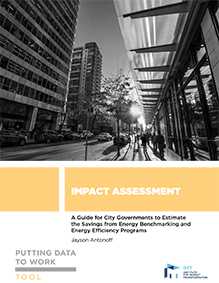A Guide for City Governments to Estimate the Savings from Energy Benchmarking and Energy Efficiency Programs
Mandatory programs that require benchmarking of building performance—wherein building owners track their building’s energy and/or water use and report the results to local government departments—have become one of the common tools for policymakers striving to reduce energy use within their local building stock. Now that these policies have been in place in some U. S. cities for more than six years, the question that is rightfully being asked is whether benchmarking policies are having the intended energy- and carbon-saving impact.
This paper describes how cities are actively using benchmarking data to evaluate the impact of their energy efficiency policies and programs, and includes best practices for other cities to conduct similar analyses.
This report is part of IMT’s Putting Data to Work toolkit. This comprehensive toolkit is the result of a three-year pilot project that aimed to use building performance data and asset information to help city government sustainability leaders, utilities, and efficiency program administrators and implementers make more informed business decisions and increase building efficiency. The project examined energy efficiency program design and delivery in the District of Columbia and New York City to produce a toolkit of best practices, actionable tools, and case studies to enable other local governments, utilities, and efficiency program implementers to replicate successes. The full toolkit, as well as details on upcoming blogs and webinars associate with the project, is available at imt.org/PuttingDatatoWork.
